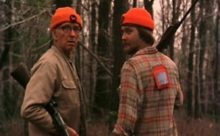Buck Season at Bear Meadows Sunset—George Hornbein’s Recollections in 2022
Buck Season at Bear Meadows Sunset—George Hornbein’s Recollections in 2022
The hunters were all from nearby communities. Dale, who was the retiring hunt captain, was the bar tender at Duffy's Tavern in Boalsburg, PA, and lived in Boalsburg with his wife. I visited their home on one occasion for something to do with the film. The home was dark and from another era. They heated the place with an old cast iron stove. The memorabilia they had on shelves and their mantel piece included animal skulls and pelts, guns and shells. I thought, 'this is what Beowulf’s den must have looked like.' As strange as it was for me, Dale was, as usual, hospitable and happy to answer the questions I had about the film we were making.
One time I brought my 11-year-old daughter, Beth, to the camp to meet the hunters. Dale greeted her and showed her around. He pointed out the deer heads hanging on the walls and told little stories about them. One was an elk head. Dale described how the animal was shot and put his finger to my daughter's throat to indicate where the bullet hit the elk. A bit later Beth went outside the cabin where she got chickadees to feed from her hand. I heard a commotion coming from the cabin and a group of hunters had gathered at the window to witness how Beth had befriended the birds.
One of the things that impressed me about the hunters was how kind and considerate they were to one another. Early one morning Norm was asleep in the easy chair and Dale was at his side looking out the window as if he were protecting Norm. I filmed the scene for about 15 seconds, enough time to tell this little story.
The cabin itself was made of chestnut logs that, by 1920, had disappeared from eastern forests due to the blight. So there are no cabins like it any longer. The fathers and grandfathers of the men we filmed had been spending deer season in the log cabin since at least that time.
When we approached the hunters about making the film there was some hesitation. There had been a number of anti-hunting films made and they did not want to be party to a film like that. We had to gain their trust. We explained that we had no intention of presenting an anti-gun or anti-hunting point of view. We just wanted people to see what a hunting camp is like, but most of these men had not seen a documentary of this type. Ken, as a folklorist, was instrumental in explaining how our film was going to let non-hunters understand the importance of this tradition. Another boost to or credibility was getting the NRA to help fund the film. In the end there was a favorable vote among the hunters in time for filming to begin.
After editing was finished we invited the hunters to our studio to see the final cut before it went off to the lab for 16 mm prints and a 2" video tape dub. There is a lot of tension for filmmakers at these screenings. In our minds the months and months of efforts were over, but we didn't know for sure if our efforts had accurately portrayed life in the Bear Meadow Camp. When the final credits rolled there wasn't any applause - I was afraid we had missed the mark. The lights went on and I saw that many of the men were drying their eyes. We had done it.
